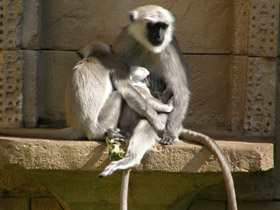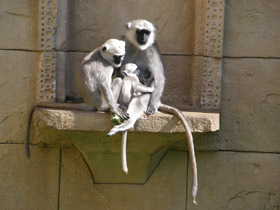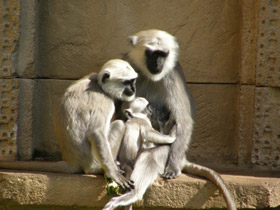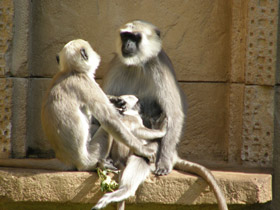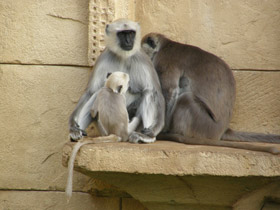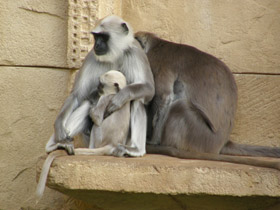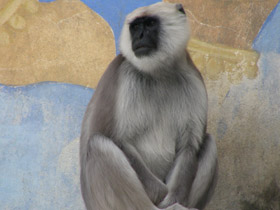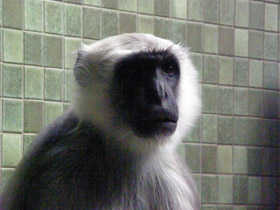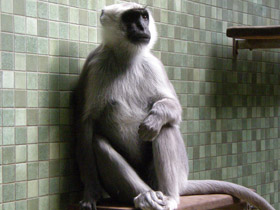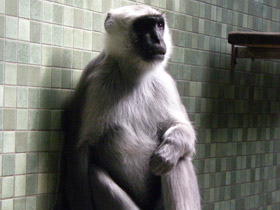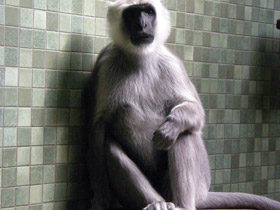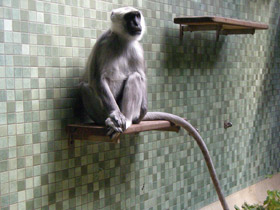The northern plains gray langur (Semnopithecus entellus), the sacred langur, Bengal sacred langur and Hanuman langur
The northern plains gray langur (Semnopithecus entellus), also known as the sacred langur, Bengal sacred langur and Hanuman langur, is a species of primate in the family Cercopithecidae.
Taxonomy
The northern plains gray langur belongs to the genus Semnopithecus along with the other Indian langurs. The southern plains gray langur was once classified as a subspecies of Semnopithecus entellus, i.e., Semnopithecus entellus dussumieri and later regarded as a separate species, i.e., Semnopithecus dussumieri, but is now regarded as an invalid taxon. Most of the specimens that had been regarded as Semnopithecus dussumieri fall within the revised range of Semnopithecus entellus.
Appearance
Adult male about 1.5 m long, of which 1 m is an unusually long tail with a tuft of hair at the end; weight 9-11 kg. Presbytis entellus is the largest of the common slender-billed genus, with highly developed supraorbital coils. The eyebrow hairs protrude forwards and point backwards at the apex. The coat colour of newborn Presbytis entellus is blackish brown, that of adults is grey and yellowish, the forehead crest is black and the small wattle is yellowish.
Behaviour and ecology
The northern plains gray langur is diurnal, and is both terrestrial and arboreal. Its natural habitats are subtropical or tropical dry forests and subtropical or tropical dry shrubland. Females groom members of both sexes but males do not groom others.
The northern plains gray langur can live in several different types of groups. It can live in groups of multiple males and females, one male and multiple females or multiple males with no females, and males can also live alone without a group. Single male groups are most common. Group size can exceed 100 monkeys. Upon reaching maturity, males typically emigrate from their natal group while females typically remain. Young adult females are typically dominant over older females. When a new male takes over a group it may engage in infanticide of young fathered by the previous male or males, but this is less common when the takeover occurs slowly over several months.
The northern plains gray langur eats primarily fruits and leaves. It is able to survive on mature leaves, which is a key to its ability to survive throughout the dry season. It also eats seeds, flowers, buds, bark and insects, including caterpillars. It is also fed fruits and vegetables by humans, and some groups get a substantial portion of their diets from food provided by temples and from raiding crops.
Groups that have access to abundant food year-round, for example those that are provisioned by temples or are able to raid crops year-round, also breed throughout the year. Other groups, such as those living in forests, typically give birth between December and May. The gestation period is about 200 days. Females other than the mother alloparent the infant for the first month of its life. Weaning occurs at about 1 year and males reach maturity at about 6 to 7 year old.
The northern plains gray langur often associates with chital deer. Both species respond to each other's alarm calls. The chital seem to benefit from the vigilance of male langurs watching for predators in the trees, while the langurs seem to benefit from the chital's better senses of smell and hearing. It also has been observed engaging in grooming sessions with rhesus macaques.
Habitat area
Semnopithecus entellus is a species of catarrhine primate of the family Cercopithecidae. Presbytis entellus is a sacred monkey of the Hindus, found in most parts of Hindustan, and the area of its distribution is steadily increasing, as it not only enjoys the protection and patronage of man, but is especially imported in some areas. In addition to Hindustan, Presbytis entellus is also common in Sri Lanka and Pakistan, penetrates river valleys as far south as Tibet and is found in the Himalayas up to altitudes of 4,000m.
Social behaviour and reproduction
They live in herds of 25-30 individuals, located in an area of 6 (in dense forests) to 13 km2 (in dry open areas). Herd size varies, with small groups of a single male and larger groups of several males.
From time to time, battles arise between male Presbytis entellus for the right to become the new leader of the herd. The victorious male drives the former leader (as well as other males that have matured) out of the group, and kills all the former leader's offspring. After losing their offspring, the females are ready to mate again. In this way, the new leader secures her position and provides the best conditions for her offspring.
When a female gives birth to a calf, all the other females surround it with care. A few hours after the birth, the mother even allows another female to hold her calf. However, once the colour of the calf's coat begins to change, the females' interest in it gradually diminishes. The mother feeds the calf with her milk until 15 months of age, and females reach sexual maturity at 4 years of age; males do not reach sexual maturity until 6-7 years of age.
Conservation
The northern plains gray langur is listed as least concern on the IUCN Red List, it is threatened by habitat loss. The northern plains gray langur adapts to many habitats and the Hindu religion considers the northern plains gray langur to be sacred. Hence it has large population within India, including within towns and cities. It is subject to some threats, including road kill, attacks by dogs, forest fires and diseases caught from domestic animals. It is sometimes hunted for food, especially within the states of Odisha and Andhra Pradesh and is sometimes killed by humans to prevent it from raiding crops.

















